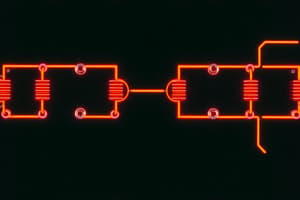Podcast
Questions and Answers
What is the series circuit rule?
What is the series circuit rule?
- The total resistance of a series circuit is equal to the sum of the resistors.
- Voltage is the same across each component of the parallel circuit.
- The same current flows through each part of a series circuit. (correct)
- If one of the parallel paths is broken, current will continue to flow.
What is the total resistance of a series circuit?
What is the total resistance of a series circuit?
The total resistance is equal to the sum of the individual resistances.
What does the voltage applied to a series circuit equal?
What does the voltage applied to a series circuit equal?
The voltage is equal to the sum of the individual voltage drops.
The voltage drop across a resistor in a series circuit is directly proportional to the size of the resistor.
The voltage drop across a resistor in a series circuit is directly proportional to the size of the resistor.
If the circuit is broken at any point in a series circuit, current will continue to flow.
If the circuit is broken at any point in a series circuit, current will continue to flow.
What defines a parallel circuit?
What defines a parallel circuit?
In a parallel circuit, voltage is the same across each component.
In a parallel circuit, voltage is the same across each component.
What is the relation of currents in a parallel circuit?
What is the relation of currents in a parallel circuit?
You can find total resistance in a parallel circuit with the formula ______
You can find total resistance in a parallel circuit with the formula ______
If one of the parallel paths is broken, the current will stop flowing in all the other paths.
If one of the parallel paths is broken, the current will stop flowing in all the other paths.
Flashcards are hidden until you start studying
Study Notes
Series Circuit Rules
- In a series circuit, the same current flows through every component.
- Total resistance in a series circuit equals the sum of individual resistances.
- The total voltage across the circuit is the sum of voltage drops across each component.
- Voltage drop across a resistor is directly proportional to its resistance; higher resistance results in a larger voltage drop.
- If the circuit is interrupted (broken) at any point, no current can flow.
Parallel Circuit Rules
- A parallel circuit features two or more pathways for electric current to flow.
- Voltage remains consistent across each component of a parallel circuit.
- The total current flowing from the source is equal to the sum of currents through each parallel path.
- Total resistance in a parallel circuit can be calculated using the formula: 1/Rt = 1/R1 + 1/R2 + ...
- If one path in the parallel circuit fails, current continues to flow through the remaining paths.
Studying That Suits You
Use AI to generate personalized quizzes and flashcards to suit your learning preferences.




